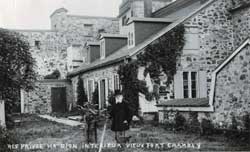Joseph-Octave Dion and the conservation of Fort Chambly
Fort Chambly National Historic Site

Joseph-Octave Dion
© Parks Canada
In 1854, an inspector of fortifications wrote his report on the state of Fort Chambly: he wrote that the fort was in a general state of decrepitude, and he recommended against making repairs. The British Army, which had occupied it since 1760, was on the way to leaving it. The fort then fell prey to time and harsh weather.
Joseph-Octave Dion, a citizen of Chambly born in 1838 and imbued with a passion for history, would take on saving the vestiges of the ruin. Returning from Montreal, where he had begun a career as a journalist, Dion settled in his home town as an agent of La Minerve, an influential newspaper of that era. He was dismayed to discover the advanced degradation state of the fort near where he had grown up: some of the walls seemed likely to crumble, and looters were removing some materials. Dion set out to convince the authorities of the importance of preserving this reminder of the French presence in Canada.
Starting in 1866, Dion undertook a flurry of steps toward restoring the fort. He launched several subscriptions to gather the funds needed for his projects, organized guided tours of the fort, and in 1875 published the first history of the building.
Dion would have to wait until 1881 to see his dream come to fruition. The unveiling of a monument commemorating Charles-Michel de Salaberry gave him the opportunity to persuade several political figures of the soundness of his project. The following year, the Department of Public Works provided $1,000 for the overhaul of the fort and appointed Dion to oversee the work. In 1886, Dion settled at the fort as its guardian and remained there until his death in 1916.
Thanks to the perseverance of Joseph-Octave Dion, the fort escaped certain destruction and became a major cultural focus in Chambly. Even today, this old French fort holds a noteworthy place in the imagery of people in the area.
- Date modified :